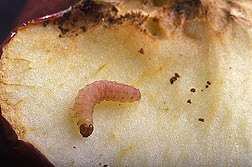This page has been archived and is being provided for reference purposes only. The page is no longer being updated, and therefore, links on the page may be invalid.
|
Read the magazine story to find out more. |
|
|
|
|
Fungal Fumes Clear Out Crop Pests
By Jan SuszkiwFebruary 19, 2010
A cocktail of compounds emitted by the beneficial fungus Muscodor albus may offer a biologically based way to fumigate certain crops and rid them of destructive pests. That’s the indication from Agricultural Research Service (ARS) studies in which scientists pitted Muscodor against potato tuber moths, apple codling moths and Tilletia fungi that cause bunt diseases in wheat.
The scientists—at ARS laboratories in Aberdeen, Idaho; Wapato, Wash., and other locations—conducted separate studies of Muscodor. However, their goal was the same: to learn whether volatile organic compounds (VOCs) released by the fungus could replace or diminish the use of synthetic pesticides.
In field trials conducted since 2007, ARS plant pathologist Blair Goates found that treating wheat seed or the soil with a formulation of Muscodor and ground rye completely prevented common bunt under moderate disease conditions. Caused by the fungus T. tritici, common bunt reduces wheat yields and grain quality. Although chemical fungicide seed treatments have kept common bunt outbreaks to a minimum, alternative controls are worth exploring if the chemicals lose effectiveness or are discontinued, notes Goates, with the ARS Small Grains and Potato Germplasm Research Unit in Aberdeen. Results from this study were published in the Canadian Journal of Microbiology.
At the ARS Yakima Agricultural Research Laboratory in Wapato, entomologist Lerry Lacey and colleagues tested Muscodor against potato tuber moths, which damage potato leaves and tubers, and apple codling moths, which feed inside apples. In fumigation chamber tests, 85 to 91 percent of adult codling moths died when exposed to Muscodor fumes, while 62 to 71 percent of larvae died or failed to pupate. In apple storage tests, a 14-day exposure to Muscodor killed 100 percent of cocooned codling moth larvae, which are especially difficult to control.
Lacey and colleagues have also been testing Muscodor’s effectiveness in biofumigating sealed cartons of apples stored at various temperatures. The results have been encouraging so far, he reports, and there appears to be no adverse effect on the apples’ color, firmness or other characteristics.
Read more about this research in the February 2010 issue of Agricultural Research magazine.
ARS is the principal intramural scientific research agency of the U.S. Department of Agriculture (USDA). The research supports the USDA priority of promoting international food security.

